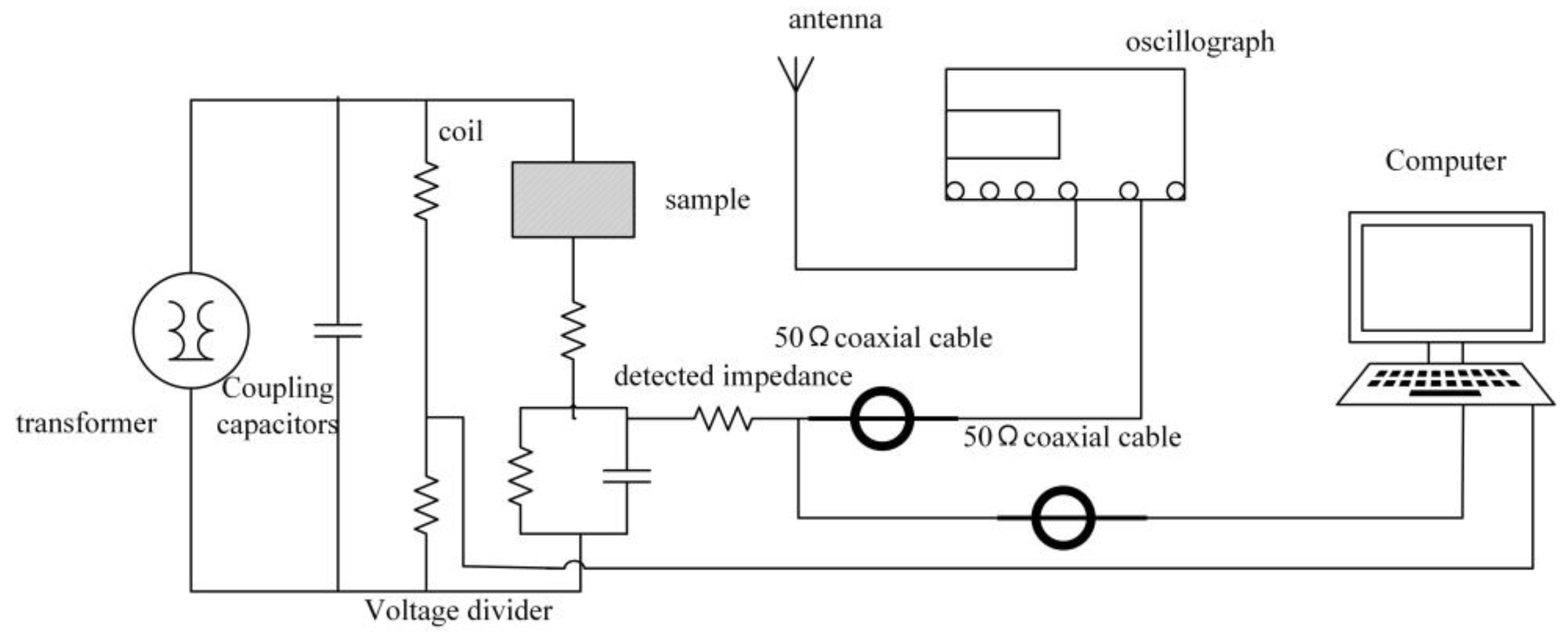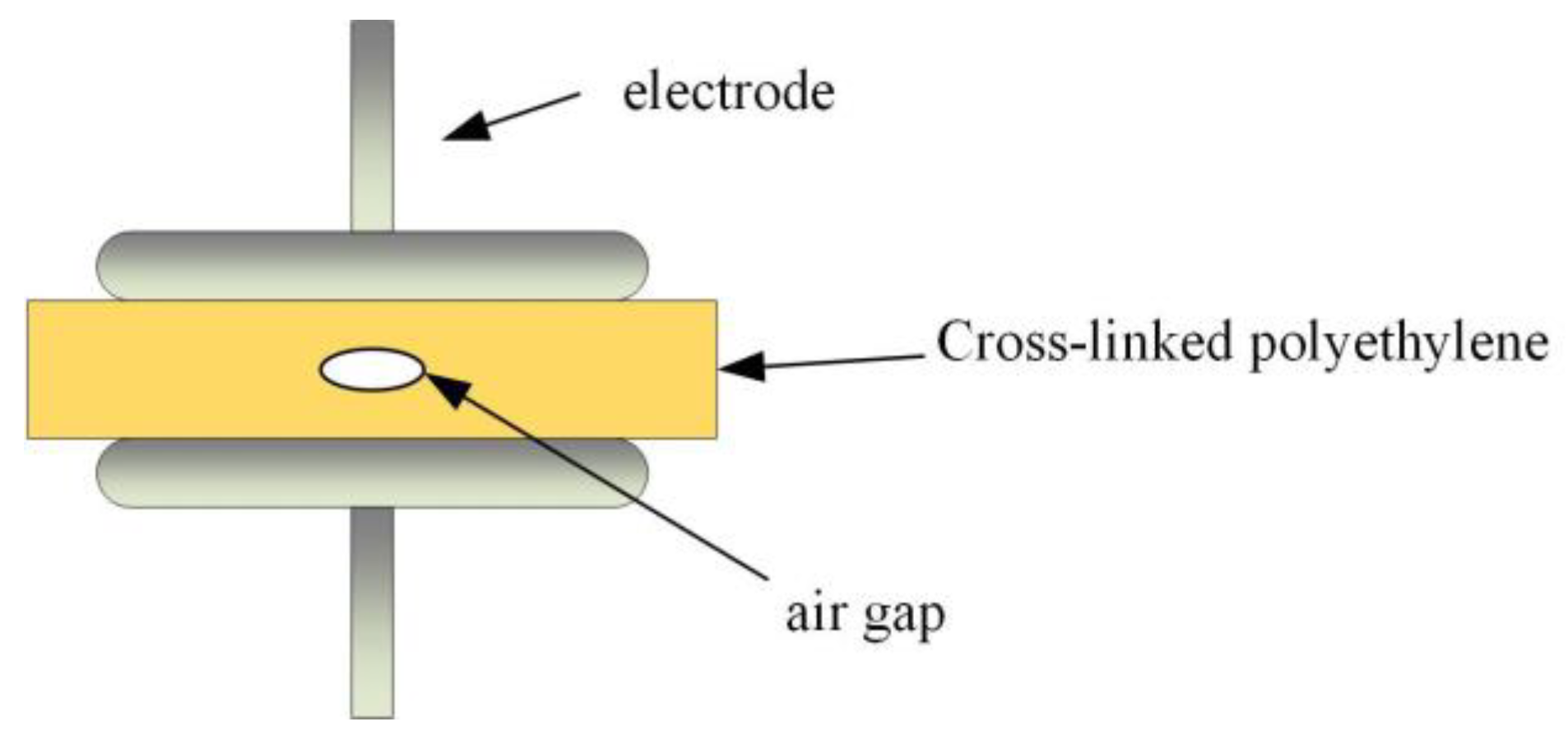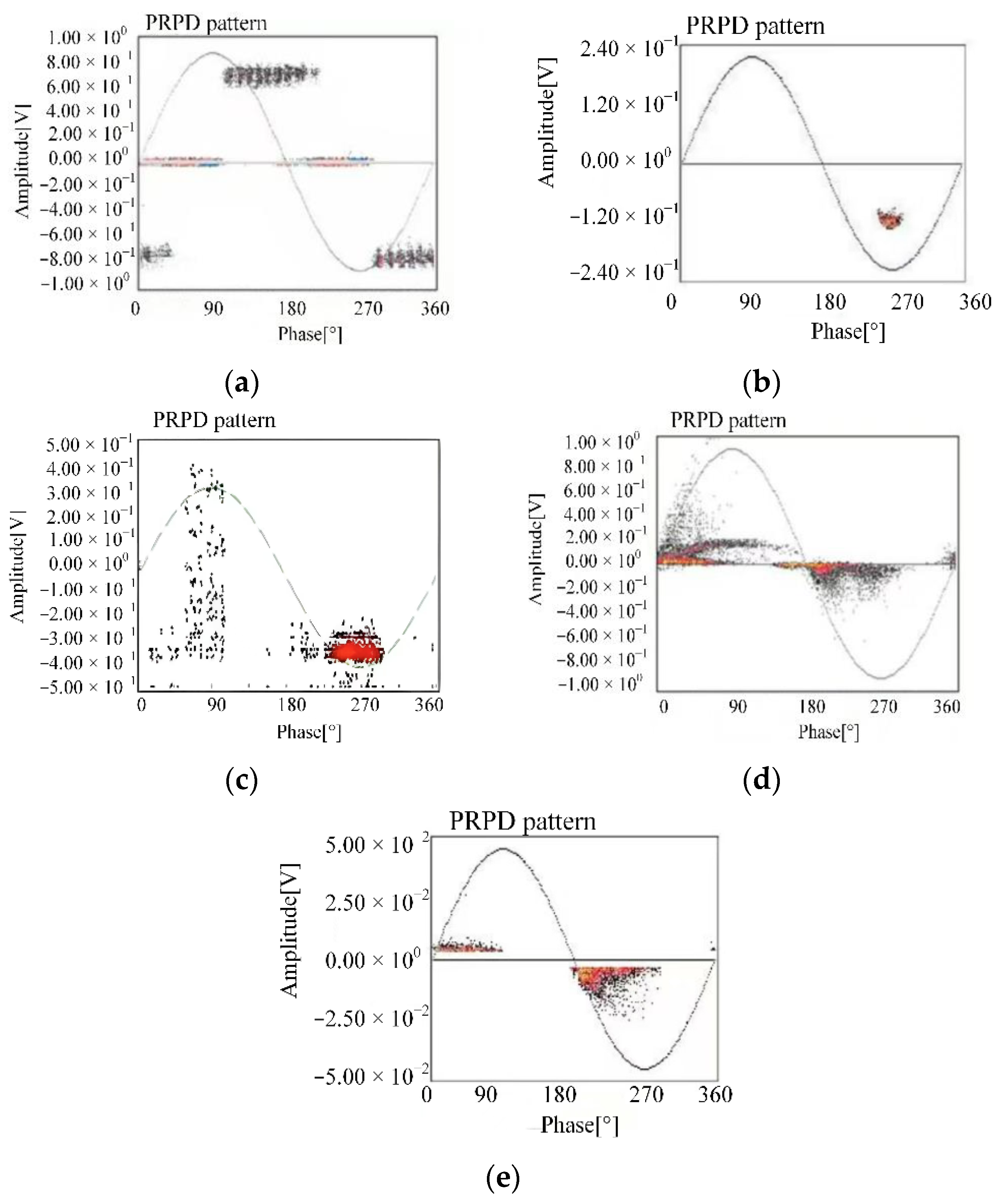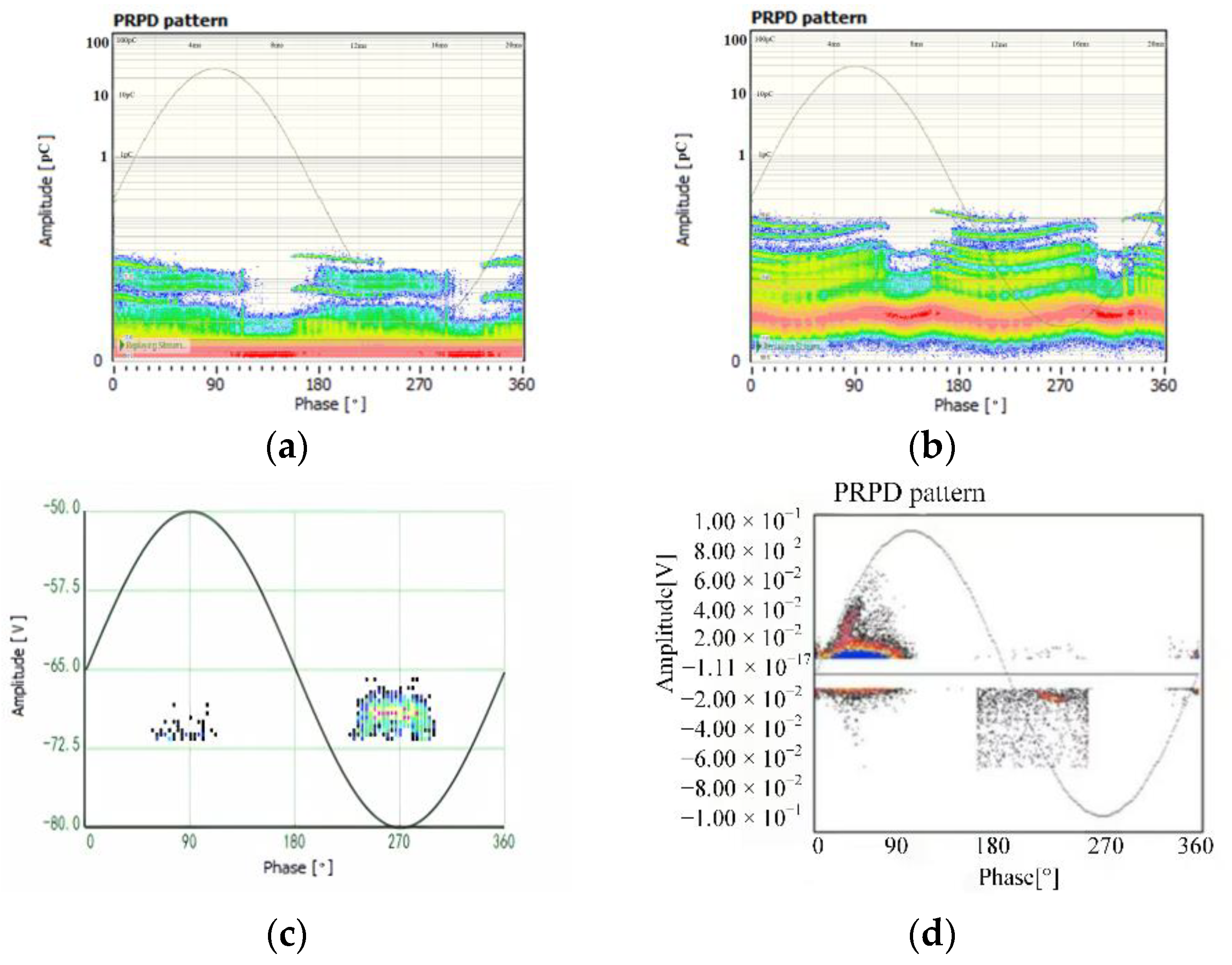Research on Partial Discharge Spectrum Recognition Technology Used in Power Cables Based on Convolutional Neural Networks
Abstract
1. Introduction
2. Materials and Methods
2.1. Partial Release Graph Training Based on Convolutional Neural Network
2.2. Image Preprocessing Technology
2.3. Extraction of Spectral Feature Parameters
3. Results
3.1. Establishment of a Database of Typical and Field Noise Spectra of Partial Discharge
3.1.1. Construction of Laboratory Test Platform and Typical Partial Discharge Pulse Phase Distribution Spectrum
3.1.2. Field PD Pulse Phase Distribution Spectrum
3.1.3. On-Site Noise Spectrum
3.2. Feature Parameter Extraction of Grayscale Image and Partial Discharge Spectrum Verification
4. Conclusions
- (1)
- Based on the typical partial discharge spectrum in the laboratory and the partial discharge spectrum obtained in the field, the partial discharge spectrum of multiple sets of cable monitoring data and the partial discharge spectrum in the typical literature were also collected, which provided a large number of samples and data support for convolutional neural network training.
- (2)
- A feature parameter extraction method based on the graph was proposed, which improved the compatibility of the pictures obtained in the field operation and provided convenience for the field staff. With the update of the defect database and the upgrade of the system algorithm, the recognition accuracy of the convolutional neural network for the partial discharge spectrum proposed in this paper can reach more than 85%. According to the measured network delay and cloud reasoning time displayed in the operation log, the diagnosis time is less than 10 s, which is expected to greatly improve the detection efficiency of cable aging in field operations.
- (3)
- By using the convolutional neural network based on deep learning, the self-learning mechanism can be used to improve the accuracy of the system while the PD spectrum database is constantly expanding.
Author Contributions
Funding
Data Availability Statement
Acknowledgments
Conflicts of Interest
References
- DL/T2271-2021; Technical Specification for Online Monitoring System for Partial Discharge of High-Voltage Cables. National Energy Administration (NEA): Beijing, China, 2021.
- Liu, J.H.; OuYang, B.H.; Xia, R.; Fei, W.L. Assessment of the insulation aging state of high voltage XLPE cables. Electr. Power Eng. Technol. 2021, 40, 141–149. [Google Scholar]
- Zhao, F.Q.; Xiao, Y.X.; Lu, L. Investigation on Partial Discharge Characteristic Gas in XLPE. Guangdong Electr. Power 2019, 32, 130–136. [Google Scholar] [CrossRef]
- IEEE Std 4003—2006; IEEE Guide for Partial Discharge Testing of Shielded Power Cable Systems in a Field Environment. IEEE: Piscataway, NJ, USA, 2007.
- Wu, M.X.; Ouyang, B.H.; Li, W.J. Common Faults and Cause Analysis of XLPE Cables. Electr. Power 2013, 46, 66–70. [Google Scholar]
- Li, W.; Ye, C.; Li, L.Y.; Zheng, S.S. Novel Coupling Method for High-frequency Current of Partial Discharge in Switch-Gear Cabinets Used in Wind Solar & Energy Storage Stations Located in Gobi Deserts. High Volt. Appar. 2024, 1–13. [Google Scholar]
- Xu, Y.; Liu, W.D.; Chen, W.J.; Yang, J.G. Partial Discharge Characteristics of Metal Particles on Spacer Surface in GIS Based on High Sensitivity Measurement. High Volt. Eng. 2019, 45, 2707–2714. [Google Scholar]
- Su, Z.X.; Sun, K.; Ding, H.; Zhang, Z.S. Multi-source partial discharge detection method based on pulse current method and ultraviolet pulse method. Insul. Mater. 2024, 57, 101–108. [Google Scholar]
- Yan, Y.; Yao, L.L.; Wu, M.; Liu, Y.B.; Gao, J.H. Highly Sensitive Flexible PZT Piezoelectric Ultrasonic Sensor for Cable Partial Discharge Ultrasonic Detection. High Volt. Eng. 2024, 1–9. [Google Scholar] [CrossRef]
- Li, W.; Zhang, L.G.; Li, L.L.; Kong, J. Analysis on UHF signal intermittency and effective detection rate of partial discharge of metal particles on GIS insulator surface. Insul. Mater. 2024, 57, 122–129. [Google Scholar]
- Li, X.; Ding, D.W.; Xu, Y. Denoising and Localization for GIS/GIL Partial Discharge Based on Ultra-high Frequency and Ultrasound Method United. High Volt. Eng. 2024, 1–10. [Google Scholar] [CrossRef]
- Yang, Z.H.; Huang, H.; Liu, W.L.; Liu, Y. Partial Discharge Detection and Location Technology of Converter Transformer Based on Broadband Radio Frequency. High Volt. Eng. 2022, 48, 2952–2960. [Google Scholar]
- Xu, C.H.; Chen, J.M.; Liu, W.N.; Lu, Z.; Li, P.; Zhu, M.X. Pattern Recognition of Partial Discharge PRPD Spectrum in GIS Based on Deep Residual Network. High Volt. Eng. 2022, 48, 1113–1123. [Google Scholar]
- Huang, X.Y.; Xiong, J.; Zhang, Y.; Liu, H.; Chen, L.; Meng, X.L.; Jiang, X.C. Partial Discharge Pattern Recognition of Switchgear Based on Residual Convolutional Neural Network. Electr. Power 2021, 54, 44–51. [Google Scholar] [CrossRef]
- Wang, Z.C.; Wang, Z.W.; Zhu, M.F.; Ji, R.H.; Zhang, B. Study on sound recognition of Partial discharge base on convolu-tional. Electron. Meas. Technol. 2023, 46, 148–155. [Google Scholar]
- Zhao, D.H.; Zhang, J.G.; Shi, L.; Qi, X.; Wang, X. Transformer Condition Monitoring and Fault Diagnosis Based on Acoustic Signal Feature Spectrogram. Electr. Autom. 2023, 45, 106–108+112. [Google Scholar]
- Tang, Z.G.; Cao, Z.; He, N.H. Application of Convolutional Neural Network Transfer Learning in Partial Discharge Type Diagnosis. High Volt. Appar. 2022, 58, 158–164. [Google Scholar]
- Ma, Y.J.; Cheng, S.S.; Ma, Y.T.; Ma, Y.D. Review of convolutional neural network and its application in intelligent transportation system. J. Traffic Transp. Eng. 2021, 21, 48–71. [Google Scholar]
- Wang, K.; Zhang, S.Q.; Li, J.Z.; Sun, J.T.; Zhao, X.Y.; Liao, R.J.; Zou, G.P. Partial discharge feature extraction and optimization based on gray image decomposition. Electr. Mach. Control 2018, 22, 25–34. [Google Scholar]
- Diao, Y.H.; Meng, Z.Y.; Wang, X.J. Research on image shape feature extraction based on Hu invariant moment. Netw. Secur. Technol. Appl. 2017, 10, 46–47. [Google Scholar]
- Liu, S.T.; Xu, Z.G.; Yang, K. Partial discharge characteristics and identification of power cables under typical defects. High Volt. Eng. 2023, 49, 36–39. [Google Scholar]
- Zhou, H.B.; Wang, J.B.; Zhou, C. Research on commutation on-site partial discharge detection instrument. Autom. Instrum. 2018, 3, 63–66. [Google Scholar]
- Wan, X.Q.; Song, H.; Luo, L.G.; Li, Z.; Sheng, G.H.; Jiang, X.C. Application of Convolutional Neural Networks in Pattern Recognition of Partial Discharge Image. Power Syst. Technol. 2019, 43, 2219–2226. [Google Scholar]













| Model | VGGNet | GoogLeNet | ResNet | The Network in This Study |
|---|---|---|---|---|
| Number of layers | 19 | 22 | 151 | 50 |
| Data augmentation | yes | yes | yes | yes |
| Inception | no | yes | no | no |
| Number of convolutional layers | 16 | 21 | 150 | 48 |
| Convolution kernel size | 3 | 7, 1, 3, 5 | 7, 1, 3, 5 | 7, 1, 3, 5 |
| Number of fully connected layers | 3 | 1 | 1 | 1 |
| The size of the fully connected layer | 4096, 4096, 1000 | 1000 | 1000 | 8 |
| Dropout | yes | yes | yes | yes |
| Regularization | no | yes | yes | yes |
| Batch normalization | no | no | yes | yes |
Disclaimer/Publisher’s Note: The statements, opinions and data contained in all publications are solely those of the individual author(s) and contributor(s) and not of MDPI and/or the editor(s). MDPI and/or the editor(s) disclaim responsibility for any injury to people or property resulting from any ideas, methods, instructions or products referred to in the content. |
© 2025 by the authors. Licensee MDPI, Basel, Switzerland. This article is an open access article distributed under the terms and conditions of the Creative Commons Attribution (CC BY) license (https://creativecommons.org/licenses/by/4.0/).
Share and Cite
Zhang, Z.; Wu, H.; Ren, W.; Yan, J.; Sun, Z.; Ding, M. Research on Partial Discharge Spectrum Recognition Technology Used in Power Cables Based on Convolutional Neural Networks. Inventions 2025, 10, 25. https://doi.org/10.3390/inventions10020025
Zhang Z, Wu H, Ren W, Yan J, Sun Z, Ding M. Research on Partial Discharge Spectrum Recognition Technology Used in Power Cables Based on Convolutional Neural Networks. Inventions. 2025; 10(2):25. https://doi.org/10.3390/inventions10020025
Chicago/Turabian StyleZhang, Zhenqing, Hao Wu, Weiyin Ren, Jian Yan, Zhefu Sun, and Man Ding. 2025. "Research on Partial Discharge Spectrum Recognition Technology Used in Power Cables Based on Convolutional Neural Networks" Inventions 10, no. 2: 25. https://doi.org/10.3390/inventions10020025
APA StyleZhang, Z., Wu, H., Ren, W., Yan, J., Sun, Z., & Ding, M. (2025). Research on Partial Discharge Spectrum Recognition Technology Used in Power Cables Based on Convolutional Neural Networks. Inventions, 10(2), 25. https://doi.org/10.3390/inventions10020025






